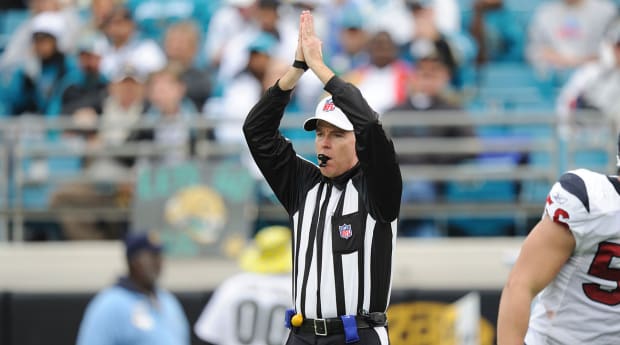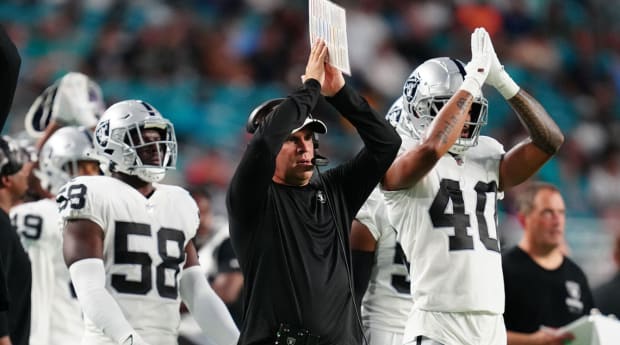Welcome to Bad Takes Week, where MMQB staffers have been asked to expand upon some of their worst football takes. Keep an eye out for more of these throughout the week, and every story is posted here.
Telling time by sundial. Listening to music on the beach with a boombox. Loading up a covered wagon and hitting the Oregon Trail.
All things that stopped happening once a better idea came along.
Welcome to the conversation around safeties in the NFL.
In the NFL’s golden age, few things about the on-field product are truly problematic. But the safety is boring and not properly rewarded.
Since the league’s inception in 1920, defenses have had a select few ways to score points. They could recover a fumble and return it for a touchdown. They could intercept a pass and run it in for six points. Or, they could tackle an opponent holding the football in the end zone, resulting in a safety worth two points.
It’s time to take one of those options away from the defense, but weaponize it further for a team’s greater good.
Instead of the traditional two-point safety whenever a player is tackled, fumbles the ball out of bounds or commits a penalty in his own end zone, let’s propose this for the next NFL competition committee meetings:
Instead of the defensive team getting two points, give that team’s offense possession at its opponent’s 20-yard line. If a safety occurs with no time remaining, there will be one untimed down.

Bill Frakes/Sports Illustrated
Safeties are hard to come by. Last season, in 272 regular-season games, 11 teams recorded a total of 13 safeties, with the Bills and Jets each registering two. On those occasions (box scores here), the teams got their two points and received free kicks, resulting in the following outcomes:
- End of game (opponent took over with six seconds left)
- Touchdown
- End of game (opponent took over with 1:33 left)
- Missed field goal
- Turnover on downs
- Punt
- End of game (opponent took over with seven seconds left)
- Touchdown
- Punt
- Punt
- Punt
- Fumble
- End of game (safety was final play)
Overall, only two of last year’s 13 safeties resulted in points on the ensuing drive. That’s nowhere near a good enough reward for stuffing an opponent’s drive short of their own goal line.
More important, two games were ended by teams cowering to run out the clock. In both situations, the new rule would have made those squads play the final seconds, potentially providing a great moment. And, if the coaches had for some reason still made the same decisions, it would have meant having to avoid a 20-yard play at the proverbial gun.
Furthermore, this rule change would add some serious spice. Consider the following situation.
A team is winning 16–10 with three minutes remaining. It’s backed up at the 2-yard line. Normally, a safety would be problematic but not devastating, especially since the defense has been playing well all afternoon.
Now run this scenario with the new rule. The game would still be 16–10 after the safety, but now the other team would need to go only 20 yards for a potentially game-winning score.
If you’re inept enough to be tackled in your own end zone, that shouldn’t be a mere two points and a free kick, which could force a team to drive at least 25 to 30 yards for a field goal or perhaps 60 to 70 for a touchdown. (A mild enough punishment that some teams take it intentionally late in games!)

Jim Rassol/USA TODAY Sports
Not everyone would be sold on the idea, (it is Bad Takes Week, after all) so we wanted to run it by an NFL defensive coordinator, and the Giants’ Wink Martindale was game.
Martindale, who has coached in the NFL since 2004, has plenty of ideas about the safety, noting that having a team backed up on its own goal line is an area his team game-plans for, because, “We know there’s blood in the water.”
But he had some reservations about our new rules proposal, saying, “Defenses have so few advantages or ways to score, so why take one away?” He even suggested that, given the degree of difficulty, maybe safeties should be worth three points.
He also said safeties are hard to get, anyway, unless the QB is dumb enough or scared enough to run out of the end zone. Martindale then added, “Yes, that was a shot at the ESPN expert!”
When told he’d been the recipient of a jab in this column, Dan Orlovsky retorted: “I was certainly dumb enough in that moment, and being chased by Jared Allen didn’t help. No excuses, that play is on me.”
Orlovsky then joked that perhaps Martindale was referring to Jimmy Garoppolo, who last year made a similar gaffe.
Finally, Martindale turned his attention to the opposite sideline and said arrogant offensive coaches who don’t play conservatively when backed up should be punished for safeties.
The longtime coach makes excellent points, and in some ways they fold into the argument for change. The safety is hard to execute, and it should be a bigger advantage to the team that earns one. My rule change would typically result in teams earning more than two points, taking over the ball already in field goal range.
Additionally, great defensive planning and arrogant offensive coaching? Again, winning that matchup should be rewarded further. Give teams an immediate red zone possession instead of a measly two points.
For Orlovsky and other quarterbacks who run out of the end zone, that humiliation is enough. But still, it should be met with harsher punishment.
However, Sports Illustrated also texted a front office source who stated he was against the change, if only because he views himself as a traditionalist. And while that’s understandable, tradition is only as good as the tradition itself. Ask America how it feels about having been forced to watch the Lions on Thanksgiving the past 20 years.
Over the past 30 years, we’ve seen the league move into the future. The best example was the two-point conversion being adopted in 1994, changing the way leads were held. Sixteen-point leads were previously untouchable in the fourth quarter. Now? They can be erased in five minutes.
For centuries, the sundial was a necessary tool. Listening to a good beat on the beach either required a strong shoulder or some additional packing space. The way west was a threat to your life.
Then changes were made through innovation. It’s time for innovation on the gridiron.







